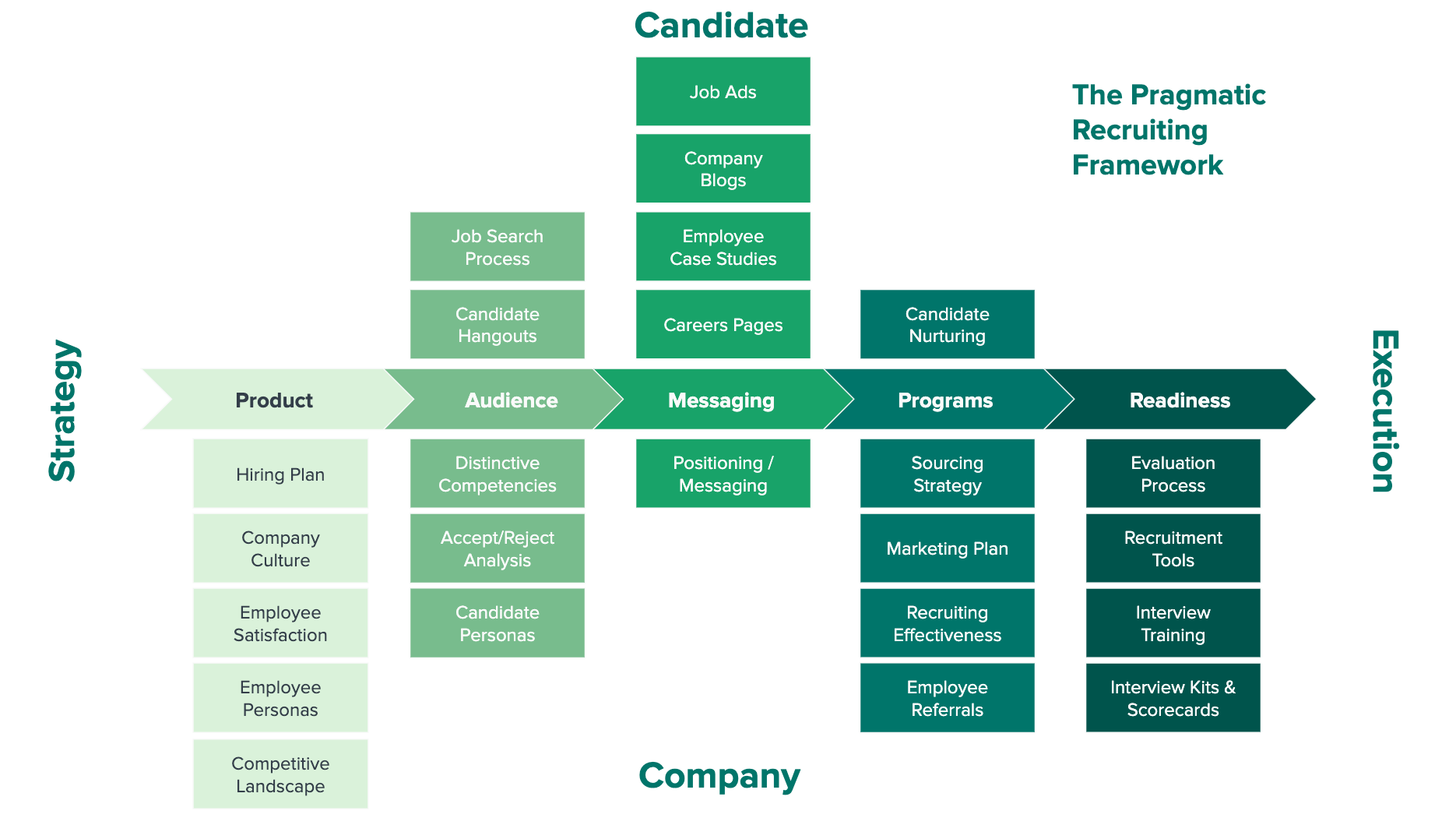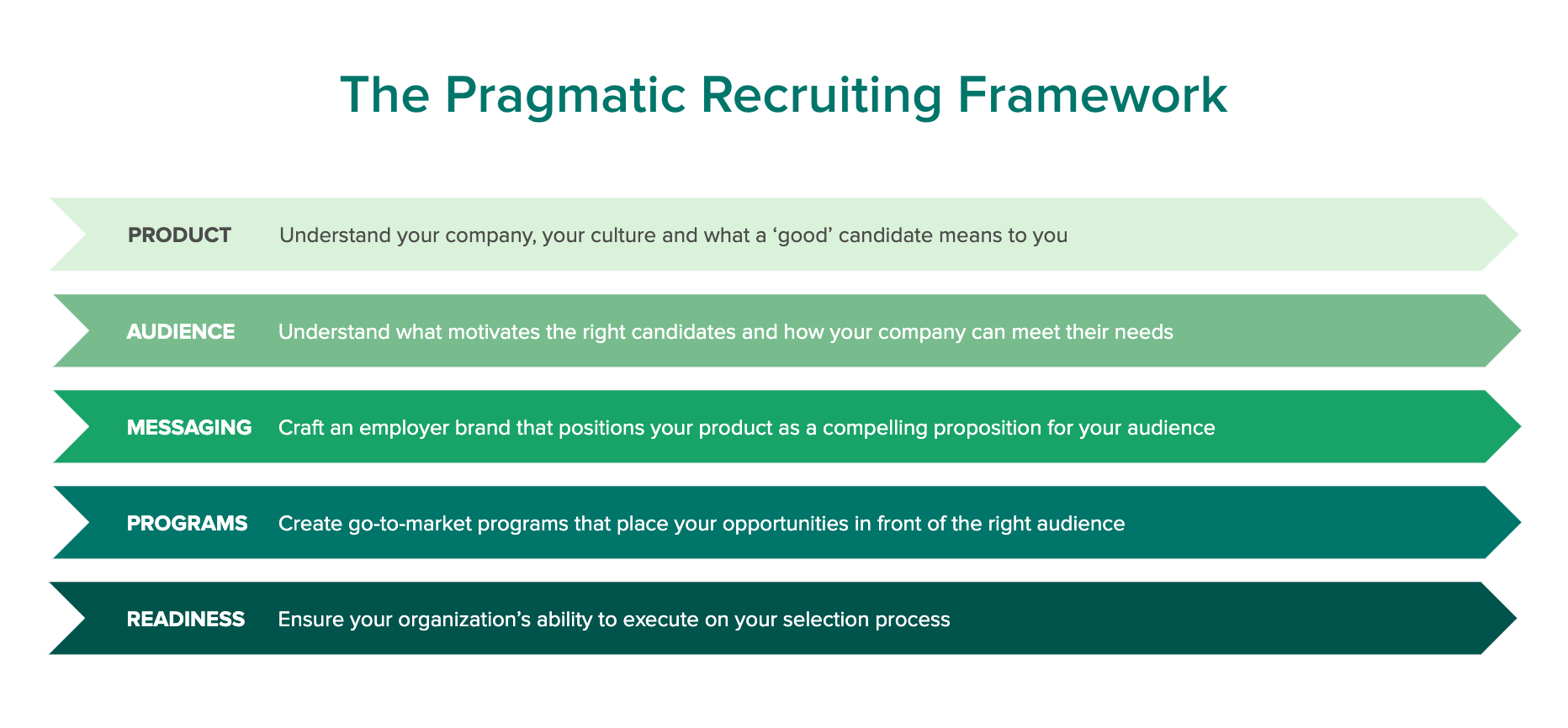The Pragmatic Recruiting Framework: A lesson from marketing

I’m not a fan of the tired rhetoric of “Recruitment is just like X”. But let’s face facts: every discipline can learn something from others. So I’ve been thinking about what recruitment can learn from product marketing and this is what I came up with – the Pragmatic Recruiting Framework:

This is as yet unfinished, because:
- You can customize as needed for your own purposes.
- I welcome your ideas as to what I can do with this.
- And mostly, call me out on my BS if need be.
For some context, this borrows very heavily from the Pragmatic Marketing Framework. The general concept is that you can’t do the things on the right (Execution) well if you don’t start with the things on the left (Strategy).
Diverting a little from the PMF, I’ve tried to split the items into those more focused on your Company (lower) and those more focused on the Candidate (higher). It’s by no means a perfect or final setup – again, I’m interested in learning what your thoughts are here, especially if you yourself are a recruiter.
I’m not suggesting that every company should spend days or weeks on each item. Even the Pragmatic Marketing Framework doesn’t suggest every item is as important for every company. What you should do is score the items based on importance to you (1–3; 1 being ‘high importance’) and consider how well you’re doing on each item (score 1–3; with 1 being ‘very well’).
Invest your time and energy on the areas of highest importance where you aren’t doing so well. And take the action steps needed to improve those areas.
Now, boiling down each stage from Strategy to Execution, you get an overview like this:

Looks simple enough, right? In fact, if you’re a recruiter, you’re probably already thinking along those lines at a subconscious level when going about your work. So let’s skip over the reasons why I’ve spent time on all this, and instead, look at the definition of the Pragmatic Marketing Framework:
The Pragmatic Marketing Framework provides a standard language for your entire product team and a blueprint of the key activities needed to bring profitable, problem-oriented products to market.
That’s how Pragmatic Marketing explain the value of their Framework. Now, just switch out all the marketing/profit/product terminology with recruitment-focused words, and you have something resembling a Pragmatic Recruiting Framework.
Let’s try it now:
The Pragmatic Recruiting Framework provides a standard language for your entire hiring team and a blueprint of the key activities needed to bring talented, high-performing employees to your company.
It’s not a silver bullet and you’re at risk of being trapped by dogma if you decide to make it an almost religious or cult-like belief. But at least you’ve got a standardized process in place which will cut down on all the headaches associated with siloed, time-consuming processes that suffer from lack of uniformity throughout. When you’re building teams or scaling rapidly after a funding round, that can get expensive. So, having a system in place will work wonders for recruiting, and ultimately, your bottom line.
Want to learn more? Catch Workable VP of Partnerships Rob Long’s keynote at RecruitCon 2019 in Nashville, Tennessee Nov. 14-15, 2019. If you miss it, watch this space for an update and post-event writeup.
Frequently asked questions
- What is a pragmatic framework?
- The pragmatic framework provides a standard language for entire product teams, including blueprints of key activities needed to bring profitable problem-oriented products from concept through launch.
- What is a product management framework?
- A Product Management Framework can be used as a set of steps to help company employees optimize the time it takes for them and their team members while still creating quality products.
- What are the five stages of product development?
- The journey of developing a new product can seem daunting. Still, it's not as difficult or expensive when you break the process down into three phases: idea generation, screening, and concept development. These stages help teams build better products in less time.




